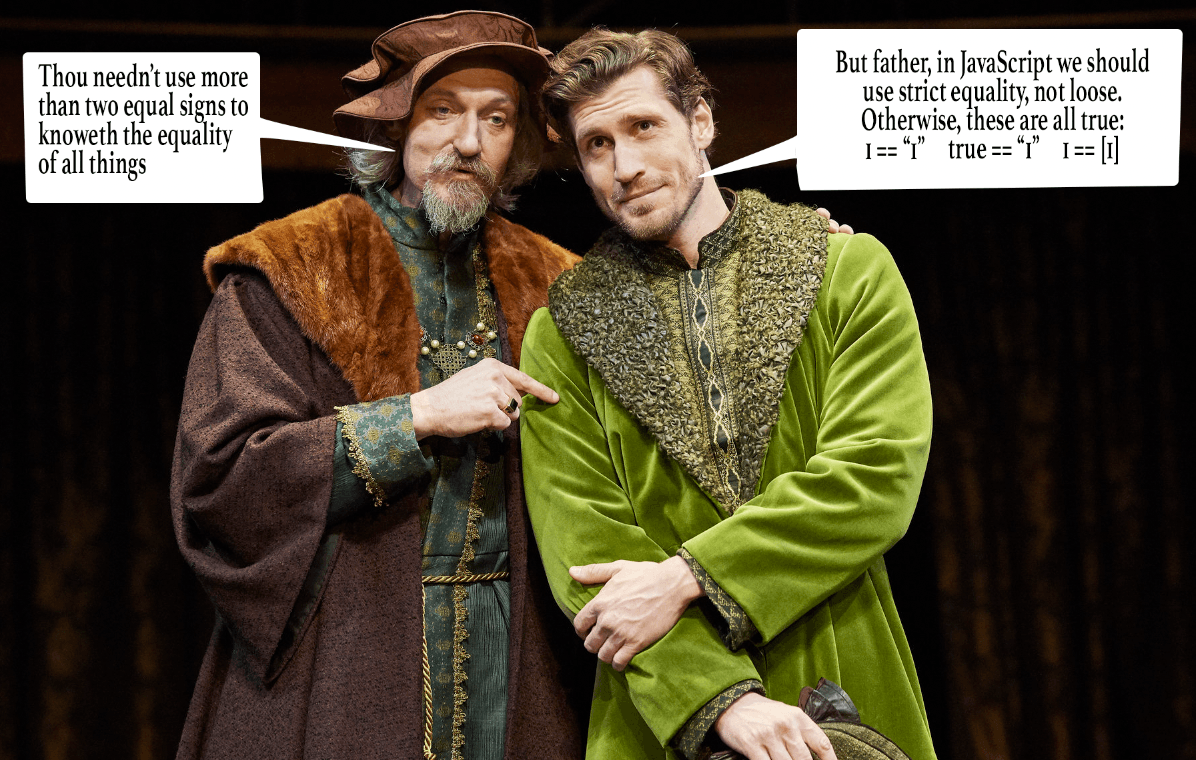- Published on
To thine own self be truthy
- Authors
- Name
- Christopher Snizik
- @casinnola
Polonius was full of garbage advice, such as this steaming lump of poop: "To thine own self be true, and it must follow as the night the day, thou canst not then be false to any man." Besides being a rambling and awkwardly constructed sentence, this is horrible advice for developers using JavaScript, where the concepts of "true" and "false" only exist in Booleans, and everything else can be evaluated using the squishy-sounding and oft-misunderstood terms, "truthy" and "falsy".
Programming depends on comparisons between two or more objects to determine their equality, or lack of. When equality is determined, we use the boolean term "true"; otherwise, we use "false".
In programming languages, Boolean is a primitive datatype with two possible values, true and false. When we are evaluating or comparing values, we are seeking to apply the Boolean concept in a non-Boolean context.
So are we talking about JavaScript's distinction between checking for equality (==, aka "abstract equality" or "double equal") or strict equality (===, aka "triple equal")? No... and yes.
Strict equality was added to JavaScript with ECMAScript 3, back in 2000. But even though it's been in the language for over two decades, its initial absence resulted in JavaScript being forever maligned for its loosey-goosey treatment of comparisons.
So what is the difference between abstract equality (==) and strict equality (===) anyway? The main difference is that abstract equality takes a very liberal approach when it comes to types.
1 == 1 is true, and 1 === 1 is also true. They both have a type of 'number' and a value of 1. Easy.
But 1 == "1" is true, whereas 1 === "1" is false. Why? Because in the abstract comparison, JavaScript really, REALLY wants these two variables to be equal. So much so that the == operator overlooks the fact that the first variable is a number type and the second is a string type. Yes, when using abstract comparison between a number and a string, JavaScript first converts the number to a string before making the comparison.
Likewise, 1 == [1] is true, as is 1 == ["1"]... because, you guessed it, JavaScript converts an both the number AND the array to strings before conmparing them, and it would even convert an array containing a single string value to a string before comparing it to the stringified result of the number 1.
This is called type coercion, and it only happens in abstract comparison, not strict.
Someone made a chart that shows the extent to which JavaScript will go to prove that there are very few special snowflakes in the world, especially not if you coerce every set of operands into the same type before comparing them.

So we can see that true is not always "true". Which brings us to "truthy" and "falsy" values.
What are "truthy" and "falsy" exactly? Are they varying degrees of truthfulness, and if so, which one is more truthy? If I were betting on them at the horse track, would my trifecta be 1) true, 2) truthy, 3) false? Or would truthy win, true place, and falsy show?
No. Truthy is neither more true nor less true than true. MDN explains them like this:
In JavaScript, a truthy value is a value that is considered true when encountered in a Boolean context. All values are truthy unless they are defined as falsy. That is, all values are truthy except
false,0,-0,0n,"",null,undefined, andNaN.
The key phrase there is "when encountered in a Boolean context." In other words, truthy and falsy give us a way of evaluating non-Booleans as if they were Booleans.
Look at the list of primitive types of the values that will be defined as falsy. We have one Boolean (false, duh), three numbers (0, -0, NaN ...yes, the primitive type of NaN, which stands for "Not-A-Number", is... number. Nice try, NaN, better luck next time) and a bigint (0n). Rep'ing for the undefined type, we have undefined. And straight out of Compton, representing the null type, give it up for null, null in da house.
That's our list of falsy values. Now for the list of truthy values... well, it's everything else. If you don't see your value in that short list of losers up there, then rest assured that JavaScript will evaluate it as true in a Boolean context.
`If you have followed me up until now, then you're left with only one question: how does JavaScript evaluate a value "in a Boolean context"? (If you haven't followed me up until now, your question may be, "What is wrong with you?")
Quite simple. Like this:
if (something) { ... }
Replace "something" with one of the 8 falsy values up there and your code block won't run. Add an else block and it will run since JavaScript checked the value against its list of 8 falsies and didn't find it. Try it in the console.
if (false) {
console.log("evaluated truthy")
} else {
console.log("evaluated falsy")
}
// "evaluated falsy"
Now put square brackets around false...
if ([false]) {
console.log("evaluated truthy")
} else {
console.log("evaluated falsy")
}
// "evaluated truthy"
Why? Look at our list of 8 falsy values up there. false is on the list, but... do you see an array of false on the list? No? Then it's truthy.
It's really that simple, and understanding how truthy and falsy work will ensure that your ternaries work correctly.
const article = "finished" ? "good bye" : "sorry, I should have provided a TL;DR"

